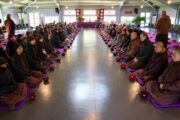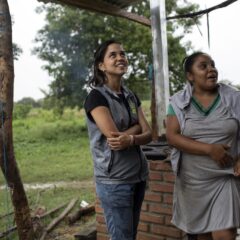The following is an excerpt of an article by Nalika Gajaweera published in the Journal of Global Buddhism. Read the full article on globalbuddhism.org.
Discussions about the gendered experience of Buddhism, especially in the modern period, often center on the status of Buddhist women vis-a-vis their male counterparts. Based on fieldwork conducted in Sri Lanka in the aftermath of the civil war that ended in 2009, this article explores some of the conceptual challenges that lay Buddhist women’s participation within nationalist spheres of civic activity pose to standard liberal feminist assessment of women’s agency and power. In particular, it examines how lay women’s religious giving and charity have played a pivotal role in efforts to sustain a hegemonic postcolonial Sinhala Buddhist imaginary. These women derive power and agency from these nation-building efforts, not in raising feminist consciousness against oppressive patriarchal nationalist project. Rather, middle-class lay Buddhist women enact their privileged place in society by shoring up culturally prescribed notions of motherhood to enhance their role as feminine moral guardians of the righteous Buddhist nation.
***
In the field of Buddhist studies, discussions about the gendered experience of Buddhism, especially in the modern period, have often centered on the status of women and the changing role of women’s authority and legitimacy vis-a-vis their male counterparts. A central question framing this and other scholarship on modernism and Buddhist women has been centered around how women resist or subvert their subordination to entrenched and pervasive patriarchy within Buddhist institutions. These inquiries have endeavored to restore and uncover hidden voices of Buddhist women in a tradition that is often dominated by men.
Over the past two decades, however, a central critique within feminist theorizing has been to interrogate the presumed universality of the category “woman” in scholarship on religion and gender. In particular, these arguments highlight the dominant liberal assessment of women’s religious practice in terms of their feminist awareness or consciousness in relation to ideas such as equality, self-autonomy, and freedom. From ethnographies on urban women’s mosque movements in Egypt (Mahmood 2005), to accounts of the everyday lives of Buddhist female renunciants in Sri Lanka (Salgado 2013), this scholarship critically calls into question the cross-cultural universality of defining women’s agency in terms of her contribution to the liberal values of feminism, i.e., her selfrealizing agency against the weight of tradition, custom, cultural, or institutional norms (see also Bedi 2006). These scholars insist that rather than evaluating women’s actions in relation to their feminist consciousness, or lack thereof, we pay closer attention to what religious women actually do in relation to the conditions in which they live, exploring the kinds of possibilities those conditions allow (see also Asad 1996).
In the case of Theravada Buddhist studies, the liberal preoccupation of understanding contemporary women’s lives in relation to issues of gender equality has also, in my view, significant implication on delimiting the scholarly field of Buddhism and gender. In particular, I suggest, it has had the effect of narrowing the field to primarily the study of female renunciants, focused as this area often is on issues involving the re-establishment of upasampadā, a struggle framed as a movement to free Buddhist women against patriarchal norms of Theravāda culture. One outcome of this focus has been the significant marginalization of studies exploring the piety and politics of lay Buddhist women.
This is evidenced by the literature. For instance, in contrast to the heavy scholarly concentration on female renunciants (see for example, Gross 1993; Bartholomeusz 1994; Cadge 2004), scholarship on lay Buddhist women, whose lives are imbricated in family life as mothers, wives, and daughters, is surprisingly less common. Although a number of authors do write on the significance of the female laity in early Buddhism or in the medieval period in Theravāda and Mahāyāna culture, drawing upon early Buddhist texts (Willis 1985; Andaya 2002; Ito 2007; Skilling 2001; Horner 1930), we find comparably little attention given to contemporary practices of Theravada laywomen today (see for noteworthy exception Huang 2013; Quli 2010; Keyes 1984; Rajasingham-Senanayake 2018). When effort is spared in this endeavor, it is often glossed over as “traditional.” As sociologist of Asian American Buddhist culture Sharon Suh has observed, “Western Buddhist feminists often overlook laywomen’s devotional practices,” characterizing such practices as “popular religion” (Suh 2004).
Lay Buddhist women are frequently so regarded, I argue, because their often “illiberal” goals and spheres of activity in the context of the family, the home, and society resist being straightjacketed into normative liberal assumptions about women’s agency and power. Despite their active engagement in civic and religious life, the agential action of lay Buddhist women often falls by the wayside of studies of Buddhist modernism for their efforts are often at odds with liberal feminist goals.
Our understanding of the lives and goals of contemporary Buddhist women’s lives could be advanced if we were to instead describe them in their own terms. As Talal Asad has noted elsewhere, “this is an eminently anthropological enterprise,” which requires describing things in “terms intrinsic to the social practices, beliefs, movements and traditions of the people being referred to and not in relation to some supposed future the people are moving towards” (Asad 1996).
In what follows, I explore some of the conceptual challenges that lay Buddhist women’s participation within Buddhist nationalism in Sri Lanka pose to standard liberal conceptions of women’s agency and power. To do so, I examine how women’s religious giving and charity has played a pivotal role in efforts to sustain a hegemonic postcolonial Sinhala Buddhist imaginary in Sri Lanka. In particular, I explore the ways in which lay Sinhala Buddhist women through their charitable and social welfare activities in the service of the sangha and the rural Sinhala Buddhist poor, inhabit and deploy a recognized feminized mode of power in Buddhism – as benefactress of the Dhamma – to enhance their role as feminine moral guardians of the Buddhist nation.
In focusing on lay women’s participation within Buddhist nationalist imagination, this paper focuses on a relatively neglected aspect of research in Theravāda Buddhist women’s practice and agency, noting here that these movements dominate but do not determine the range of expressions of Sinhala Buddhist women’s activism. As numerous scholars of Sinhala Buddhist women’s lay activism in the civil and political sphere have shown, there exists a diversity of women’s activism in Sri Lanka, including anti-racist, anti-war feminist activism, critiques of state-perpetrated violence (De Alwis 2002), as well as lay and monastic Buddhist women’s non-nationalist religious and pious aspirations (Salgado 2013, Rajasingham-Senanayake 2018, Lehrer 2018). Lay Buddhist women’s civic engagement in Sinhala Buddhist patriarchal hegemonic formations provides an important corrective to the liberal feminist lens that mistakenly equates agency with rejecting such structures. Like other contributors to this Special Focus who look toward “contradictions not as problems to be resolved, but as the most valuable source of analytical stuff”, this essay thus turns to the complicity of middle-class and elite lay Buddhist women as willing and active subjects of a particularly militant patriarchal Buddhist nationalist activism.
In the first section, I look at the role that Theravāda ideals about giving and generosity, especially around notions of cultivating moral virtue, have historically played in framing ideals of femininity for lay Buddhist women. Here, I explore how laywomen’s religious giving to the sangha are envisioned as an extension of their domestic and maternal responsibilities. I then turn to look at how Sri Lanka’s experience of colonial modernity added a further dimension to Buddhist women’s responsibilities: as mothers of the nation vis-a-vis her guardianship of the Buddhist heritage as national culture. In the context of colonial modernity in Sri Lanka, Sinhala middle-class lay Buddhist women enacted their own privileged place in bourgeoisie society by shoring up culturally prescribed notions of motherhood for the purpose of the elite nationalist aspirations to realize a “righteous society.” Against this historical backdrop, I introduce ethnographic material based on long-term fieldwork I conducted in Sri Lanka between 2009 and 2010 with middle class and elite lay Buddhist women who engaged in civil society. Specifically, it examines how middle-class and elite women’s practices of giving dāna (alms-giving) to the sangha and participation in charitable activities in rural villages are two means through which elite Sinhala Buddhist women enact their agency as patrons and sustainers of a (hegemonic) Sinhala Buddhist national imaginary.
The goals that these women aspire to cannot be well accounted for through the liberal feminist framework, in which women’s agency is evaluated in terms of their capacity for transcending and resisting patriarchy and asserting self-autonomy. Indeed, in the liberal feminist viewpoint, motherhood is a particularly vexed subject (Glenn, Forcey, and Chang 1994). Motherhood and family are perceived as denying identities outside of mothering and is where subordination to patriarchy originates. For instance, feminist writing on female upasampadā often frame Asian women’s renunciation as an opportunity to escape their “double burden” as wife-mother and wage earner. Yet, as Wei-Yi Cheng reminds, “Buddhist women do not exist simply as women, they are also embodied with class, racial, national, and other identities” (Cheng 2007: 6). The lived agency women enacted within these various hegemonic formations and oppressions cannot be accounted through a liberal prescription of agency.
Such groups remain underexamined in the literature on Buddhist modernism, and their “illiberal” political activism is likely to be relegated as inauthentic “bad Buddhist” expressions, which hamper the progress of Buddhist modernity. This is evidenced by the common bafflement about a Buddhist woman such as Aung San Suu Kyi. Once lionized by Western observers as a “warrior woman” for her formidable reckoning with the male-dominated Burmese military establishment and champion of socially engaged Buddhism, Suu Kyi now confounds liberal expectations in her consistent defense of military and Buddhist nationalist violence against ethnic minorities. My point here then is that even as we find the positions such lay women take disturbing, or even contradictory, these women’s political and civic lives still ought to force us to understand their lives in their own terms, rather than through liberal understandings of where they ought to be heading in the progressive feminist goal of emancipatory politics.
This ethnography thus opens up a space for a historically and contextually sensitive understanding of elite lay Buddhist women in Sri Lanka, bringing a “critical yet empathetic look” (Rambukwella 2018) at their participation in ethno-nationalist Sinhala Buddhist hegemony. Such an orientation helps us to critically think about contemporary political contexts such as ethno-religious violence in Buddhist countries like Myanmar and Sri Lanka, where many questions are raised about how “Buddhists can behave so badly.”
Read the article on globalbuddhism.org.
Nalika Gajaweera was a senior research analyst with the USC Center for Religion and Civic Culture through 2023.








